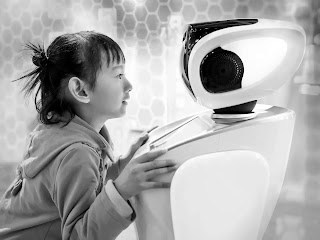Social robots are a rapidly emerging field in robotics, and are designed to interact with humans in a social context. They are equipped with advanced sensors and artificial intelligence (AI) algorithms that enable them to recognize human emotions, respond to social cues, and engage in conversations with humans.
In this article, we will discuss the impact of social robots on human-robot interaction and explore their potential applications in various industries.
What are Social Robots?
Social Robots are autonomous robots that is meant to interact with people in a social situation. These robots have powerful AI algorithms that allow them to perceive human emotions, respond to social cues, and converse with humans.
They are capable of a wide range of duties such as entertainment, education, and customer service.
Applications of Social Robots
Social robots have several uses in a variety of sectors. Social robots in healthcare can give companionship and assistance to patients, particularly the elderly and those suffering from mental health concerns.
Social robots in education can be utilized as teaching assistants or companions for children with special needs. Social robots can be used in retail to give customer assistance and information about items and services.
Design and Features of Social Robots:
Social robots are programmed to show human-like characteristics such as facial emotions and body language. They can also be outfitted with sensors that allow them to sense their surroundings and interact with humans in a more natural manner.
Social robots are frequently built to be pleasant and accessible, with an emphasis on participating in good social interactions with humans.
How do Social Robots Work?
To interact with humans, social robots employ a combination of sensors, algorithms, and machine learning. They can identify and respond to faces, words, and gestures.
Social robots, like humans, may learn from their interactions and modify their behaviour to the circumstance.
What are the Potential Uses of Social Robots?
Social robots might be useful in a variety of professions, including healthcare, education, and entertainment. Some of the potential applications for social robots include:
Social Robots in Healthcare:
Social robots can be used in healthcare to monitor patients, give emotional support, and aid with physical treatment.
In education, social robots can be used to teach children language, mathematics, and social skills.
Social Robots in Entertainment:
In the entertainment industry, social robots may engage with visitors at theme parks or museums, delivering a unique and engaging experience.
The Impact of Social Robots on Society:
Social robots will likely have an influence on our daily lives as they grow more prominent in society. Some of the potential societal effects of social robots include:
Changes in Employment:
If certain tasks become automated, the rise of social robots may result in changes in employment patterns. Social robots, on the other hand, may provide new career possibilities in industries such as robotics engineering and maintenance.
Ethical Considerations:
Social robots present ethical problems about privacy, monitoring, and the possibility of social isolation. As social robots improve in sophistication, it will be critical to assess their societal impact and ensure that they are produced and used in an ethical and responsible manner.
The Future of Human-Robot Interaction:
Human-robot interaction might be transformed by social robots. As social robots progress, they will be able to better comprehend and respond to human emotions and behaviour.
This might pave the way for social robots to be integrated into our daily lives, offering companionship, aid, and support.
Challenges and Limitations of Social Robots:
Despite the numerous advantages of social robots, there are a number of obstacles and constraints that must be solved. One of the most difficult difficulties is guaranteeing the safety and dependability of social robots, especially in delicate situations such as healthcare.
Another problem is ensuring that social robots are developed in a culturally suitable and sensitive manner for varied cultures. In addition, there are ethical considerations that need to be addressed when it comes to the use of social robots.
FAQs about Social Robots:
Q1: Can social robots replace human interaction?
A: While social robots can provide a level of social interaction, they cannot replace the value of human interaction.
Q2: Are social robots expensive?
A: Social robots can be expensive, but the cost varies depending on the level of sophistication and functionality.
Q3: What are the potential risks of social robots?
A: Social robots raise ethical concerns around issues such as privacy, surveillance, and the potential for social isolation.
Conclusion:
Social robots are becoming an increasingly significant part of our everyday lives, with several potential uses across a wide range of sectors. As technology advances, social robots will play a larger role in human-robot interaction.
To guarantee that social robots are built and utilized in a safe and ethical manner, it is critical to address their problems and limits.








0 Comments